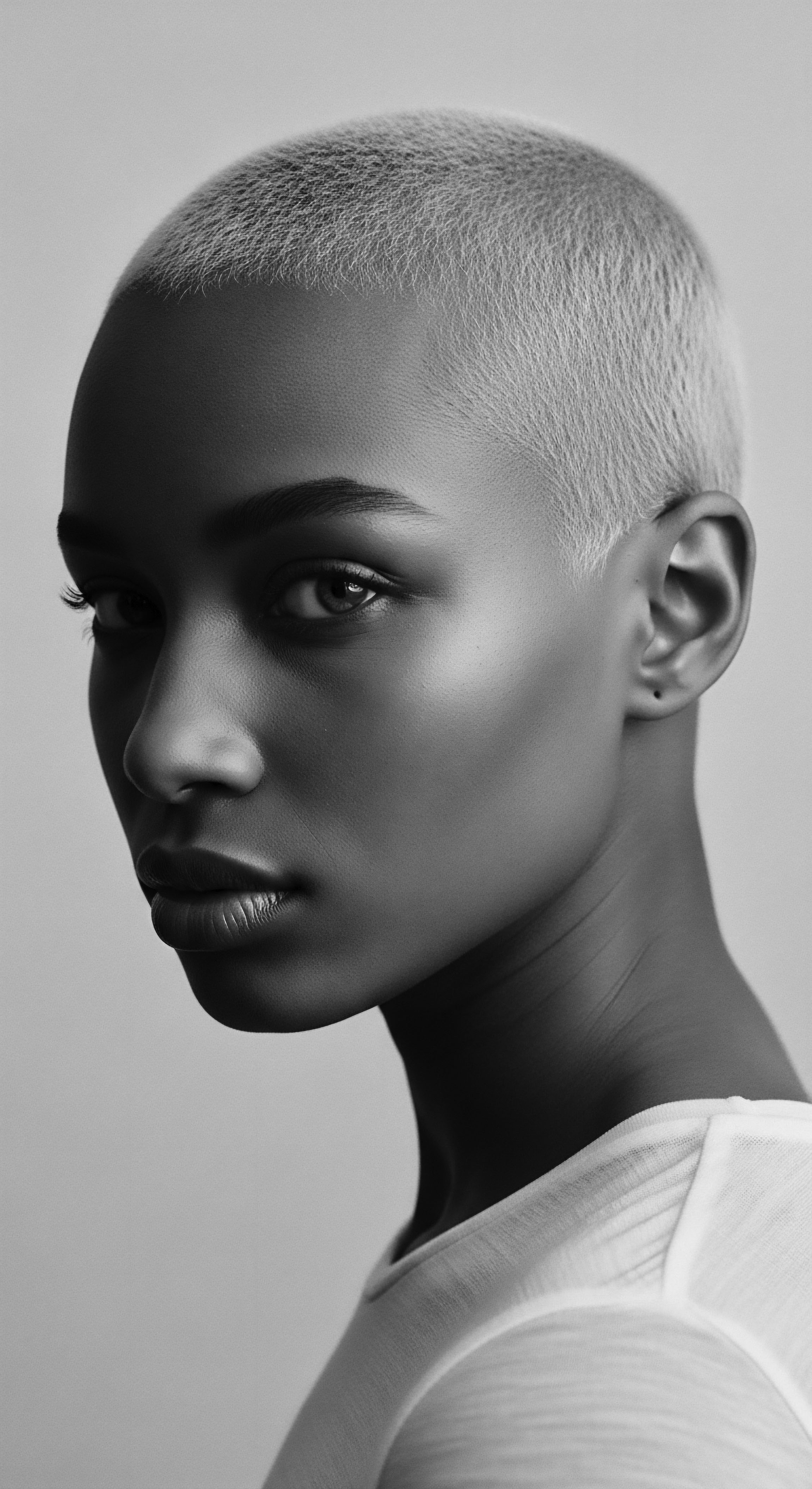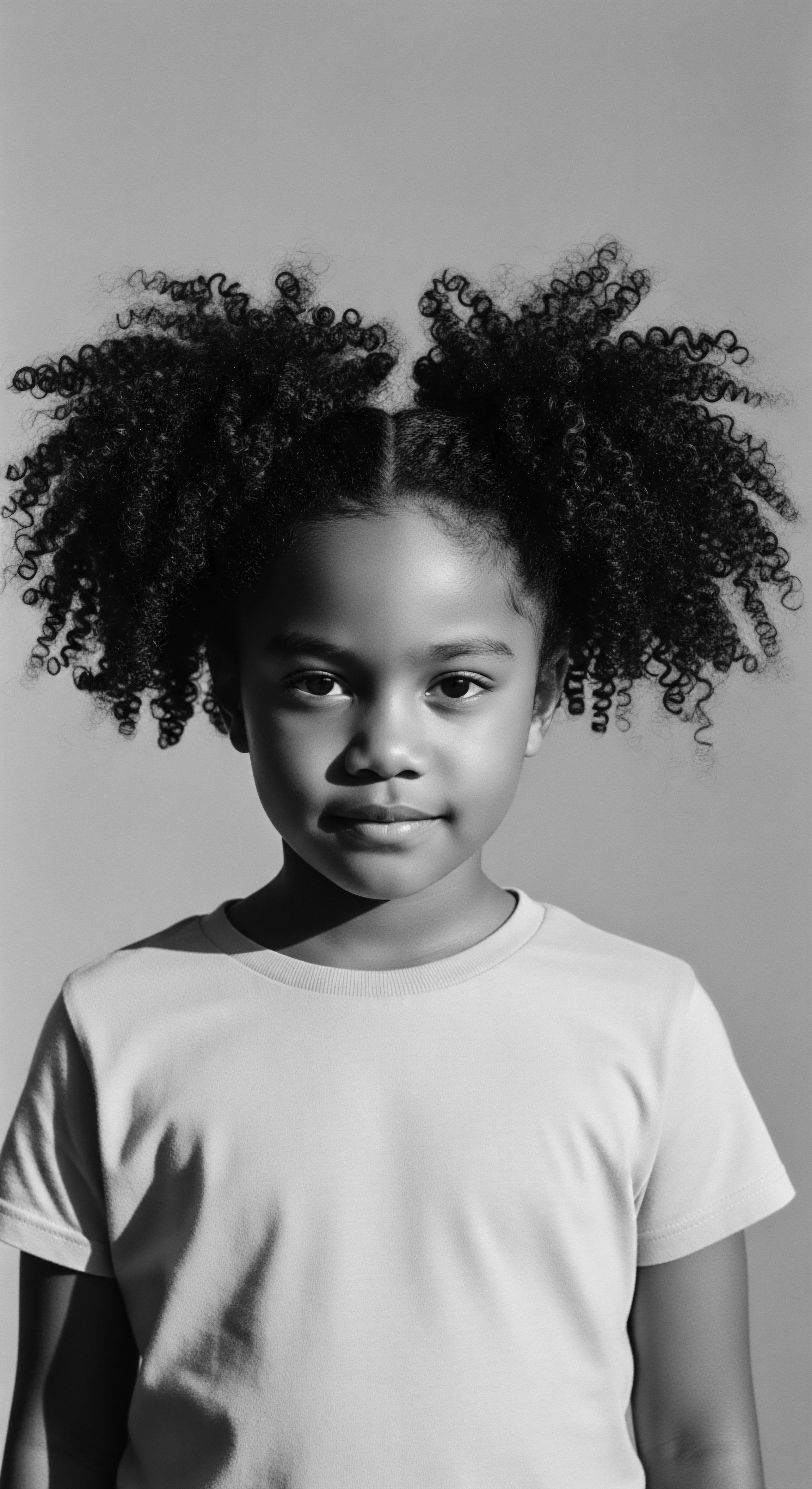
Roots
The very strands that crown us, intricate and resilient, carry within them whispers of ages past. For those of us with textured hair, this connection runs particularly deep, resonating with ancestral echoes. Our coils and curls hold not just protein bonds and moisture, but also histories of survival, celebration, and ingenuity. When we consider the question of what historical foods supported textured hair, we are not simply seeking a list of nutrients.
We are asking about the ways in which our forebears, guided by profound wisdom and a grounded understanding of their environments, sustained their physical selves, and by extension, their outward expressions of identity. The story of hair health is intertwined with the story of sustenance, a narrative of human interaction with the earth and its offerings, shaped by cultural practice and communal knowledge.

Ancestral Nourishment Principles
Across diverse Black and mixed-race communities, a core principle appears consistently ❉ health comes from within. Ancestral dietary practices, long before the advent of modern nutritional science, intuitively recognized the systemic connection between what one consumes and the vitality of one’s entire being, including hair. This holistic understanding meant that the cultivation, preparation, and consumption of food were often imbued with spiritual and communal significance, far beyond mere caloric intake. The choice of foods was often dictated by what was available seasonally and regionally, leading to rich, biodiverse diets.
Consider the dietary patterns prevalent in many traditional African societies. These were often rooted in plant-based sustenance, abundant with whole grains, legumes, vegetables, and fruits. Lean meats and fish, when available, played a supplementary role or were reserved for special occasions.
This dietary framework provided a wealth of vitamins, minerals, antioxidants, and healthy fats, all of which contribute to strong, lustrous hair. The ingenuity lay in recognizing which natural provisions offered specific benefits, long before scientific labels like “biotin” or “omega-3” existed.
Historical foodways reveal a deep-seated knowledge that linked internal nourishment to outward vitality, particularly in the context of textured hair.

Dietary Pillars of Hair Vitality
The core components of textured hair, primarily keratin protein, depend on a consistent supply of specific nutrients for optimal formation and health. Ancestral diets, through their balance and diversity, naturally provided these building blocks.
- Proteins ❉ Hair is almost entirely protein. Traditional diets often featured sources like various beans, lentils, and groundnuts (peanuts), which are rich in plant-based proteins. In coastal or riverside communities, fatty fish such as mackerel, sardines, and catfish provided complete proteins and healthy fats. These elements supplied the amino acids necessary for keratin synthesis, preventing brittleness and weakness.
- Iron ❉ Iron carries oxygen to hair follicles, a process vital for growth. Leafy greens like spinach, pumpkin leaves (Ugu), and amaranth, staples in many African diets, are iron-rich. Historically, the consumption of these greens, often cooked with iron pots, may have further enhanced iron absorption.
- Vitamins A and C ❉ Vitamin A supports sebum production, the scalp’s natural oil, keeping hair moisturized and shiny. Sweet potatoes, a common staple across various diasporic communities, are packed with beta-carotene, which converts to vitamin A. Vitamin C, crucial for collagen production which strengthens hair strands, was abundant in fruits like mangoes, papayas, and citrus, alongside leafy greens.
- Zinc and Selenium ❉ These minerals contribute to hair growth and repair. Beans, nuts, and seeds offered valuable sources of zinc. Selenium, found in whole grains and certain fish, also played a protective role against oxidative damage to hair follicles.

What Are the Fundamental Nutritional Needs of Textured Hair?
Textured hair, with its unique curl patterns and susceptibility to dryness, often requires specific internal support. The natural bends and twists of coily and curly strands mean that natural oils from the scalp have a more challenging journey down the hair shaft, making external moisture and internal nourishment all the more critical. Historically, diets that fostered hydrated skin and robust cellular activity throughout the body would indirectly contribute to healthier hair.
Modern science validates much of this ancestral understanding. Protein deficiency, for instance, can lead to hair fragility and even loss, as hair is composed of keratin. Vitamins like biotin (B7), essential for keratin production, are present in foods like eggs, sweet potatoes, and spinach.
Omega-3 fatty acids, found in oily fish and certain seeds, work to reduce inflammation on the scalp and promote circulation to hair follicles, providing foundational support for hair strength. The consistency of these dietary components in historical settings provided a natural, preventative approach to maintaining hair health.
| Nutrient Protein |
| Ancestral Food Source Beans, Lentils, Groundnuts, Fatty Fish (Mackerel, Sardines) |
| Hair Health Connection Building blocks for keratin, supports strand strength and growth. |
| Nutrient Iron |
| Ancestral Food Source Leafy Greens (Spinach, Amaranth, Ugu), Legumes |
| Hair Health Connection Oxygen transport to hair follicles, vital for healthy growth cycles. |
| Nutrient Vitamin A (Beta-carotene) |
| Ancestral Food Source Sweet Potatoes, Carrots, Mangoes, Leafy Greens |
| Hair Health Connection Aids sebum production for natural moisture; supports cell growth. |
| Nutrient Vitamin C |
| Ancestral Food Source Citrus Fruits, Papaya, Bell Peppers, Leafy Greens |
| Hair Health Connection Collagen synthesis for hair shaft integrity; antioxidant. |
| Nutrient Omega-3 Fatty Acids |
| Ancestral Food Source Fatty Fish (Salmon, Mackerel), Walnuts, Flaxseeds |
| Hair Health Connection Reduces scalp inflammation, supports follicular blood flow and shine. |
| Nutrient This table highlights how traditional diets naturally provided essential nutrients, supporting textured hair through generations. |

Ritual
The careful styling of textured hair has always been more than a mere aesthetic pursuit; it is a profound ritual, a living art form passed down through generations. These acts of shaping, twisting, and braiding carry stories, identities, and spiritual meaning. They were often communal events, a time for sharing wisdom, laughter, and support.
Within this tender thread of styling tradition, the role of internal nourishment, gleaned from historical foods, provided the very resilience and pliability necessary for these intricate expressions. Without strong, supple hair, many of the protective and celebratory styles would simply not have been possible.

How Did Diet Influence Historical Hair Styling Practices?
The physical attributes of textured hair—its elasticity, its luster, its very integrity—are deeply connected to the body’s internal state. A diet rich in essential nutrients would yield hair that was less prone to breakage, more receptive to moisture, and easier to manipulate into the complex styles characteristic of many African and diasporic cultures. Think of the elaborate braided patterns of the Mandingo or Yoruba peoples, styles that conveyed social status, marital standing, or even tribal affiliation.
Such styles required hair that could endure hours of careful tension and shaping without succumbing to stress. The ancestral foods providing protein, healthy fats, and B vitamins contributed directly to this strength and flexibility.
Consider too the practicality of hair care in times without manufactured products. The very sheen and “slip” of the hair, allowing for smooth parting and weaving, would be enhanced by a diet that promoted natural sebum production and cell health. A scalp nourished from within, less prone to dryness or irritation, would also provide a healthier foundation for long-lasting styles.
Traditional African societies prioritized thick, long, neat hair as a sign of well-being and fertility. This external presentation was a direct reflection of an internal harmony achieved through diet and holistic living.
The resilience of textured hair, essential for intricate historical styles, was a direct reflection of nourishing ancestral diets.

Protective Styles and Sustenance
Protective styles, from cornrows to bantu knots, served vital functions ❉ safeguarding the hair from environmental damage, retaining moisture, and minimizing manipulation. The ability of hair to hold these styles, sometimes for weeks, depended on its inherent strength. Historical foodways provided this underlying support.
The availability of nutrient-dense foods meant that the hair strands themselves were structurally sound, less likely to snap under the tension of braiding or twisting. In regions where access to clean water or external conditioning agents might have been limited, the internal lubrication provided by healthy fats and adequate hydration through traditional beverages became even more significant. For example, the common consumption of hydrating soups and stews, often made with leafy greens and root vegetables, would contribute to overall bodily hydration, which extends to hair health.
The tradition of braiding rice or other grains into the hair of enslaved Africans during the Middle Passage, as a desperate measure for survival, offers a poignant, albeit tragic, testament to the understanding of food as fundamental sustenance, even for the body’s external adornments. This practice underscores the deep, intuitive connection between food and survival, extending to every part of the human form.

Traditional Tools and Their Dietary Partnership
The tools of ancestral hair care were often simple yet effective ❉ combs carved from wood or bone, various cords, and natural fibers for extensions. These tools were used in conjunction with the natural properties of hair, which were, in turn, supported by diet.
- Combs and Picks ❉ The ability to detangle and separate hair smoothly, without excessive breakage, relied on hair that was internally moisturized and supple. Diets rich in omega-3s and other healthy fats would contribute to this pliability.
- Natural Fibers for Adornment ❉ While not a food, the use of fibers, beads, and shells in hair required hair strong enough to bear their weight and integrate seamlessly, a strength rooted in good nutrition.
- Fingers and Hands ❉ The most fundamental tools, human hands, applied traditional oils and butters derived from plants like shea, palm, or coconut. The efficacy of these topical applications was amplified by the hair’s internal health, a product of dietary intake.

Relay
The ancestral knowledge of sustaining textured hair through dietary means has cascaded through generations, a living archive transmitted not just through words, but through shared meals and communal practices. This relay of wisdom from past to present allows us to perceive modern nutritional science not as a replacement for traditional understanding, but as a lens through which we can further appreciate the ingenuity of our forebears. The question of what historical foods supported textured hair becomes a pathway to understanding the resilience of these practices, demonstrating how science often validates the deep, intuitive wisdom of those who walked before us.

Ancestral Wisdom and Modern Science
The nutritional science of today, with its meticulous breakdown of vitamins, minerals, and macronutrients, offers a contemporary language to describe what ancient communities understood through observation and experience. For instance, traditional West African diets often incorporate a wide array of leafy greens such as fluted pumpkin leaves (Ugu) or amaranth, alongside various legumes and root vegetables. These foods, consumed regularly, provided ample iron, zinc, and a spectrum of B vitamins. We now know these are critically important for the hair growth cycle and the structural integrity of hair protein.
A deficiency in iron, for instance, is recognized as a common factor in hair thinning and loss. The consistent consumption of iron-rich greens by ancestral communities thus offered a natural, systemic approach to maintaining robust hair.
Moreover, research into ethnobotanical practices in Africa reveals a sophisticated understanding of plants for cosmetic uses, including hair care. While many studies focus on topical applications, the systemic effect of ingesting these plants as part of the diet, loosely described as “nutrition,” is also gaining attention. This points to a deeper, more integrated health philosophy where food and medicine were not distinct categories, but rather interwoven aspects of a wellness practice.

How Does Historical Dietary Knowledge Inform Holistic Hair Care?
Holistic hair care, in its truest sense, looks beyond external products to the internal ecosystem of the body. Historical dietary patterns, particularly those of the African diaspora, offer a powerful blueprint for this approach. They underscore the idea that vibrant hair is a manifestation of a balanced internal state.
Consider the prominence of traditional soups, stews, and porridges in African and Caribbean cuisines. These dishes, often slow-cooked with a medley of vegetables, legumes, and sometimes lean proteins, maximized nutrient extraction and digestibility. Ingredients like okra, often found in these stews, are rich in mucilage, which contributes to slippery, conditioning properties when used topically, but also provides fiber and hydration when consumed. The consistent intake of such nutrient-dense, easily assimilable meals would provide a steady supply of micronutrients necessary for continuous hair renewal.
A significant example appears in the work on the African Heritage Diet, which emphasizes a return to traditional eating patterns that prioritizes leafy greens, vegetables, fruits, nuts, seeds, whole grains, beans, and tubers. This dietary framework historically protected African American ancestors from chronic diseases and provided sustained health benefits, which undoubtedly extended to the health and vitality of their hair. The dietary choices were not random; they were selections shaped by centuries of living in harmony with specific ecologies, understanding which foods supported flourishing life.
Ancestral dietary wisdom, now affirmed by modern science, teaches that hair vitality is an outward sign of internal harmony.

Case Study ❉ The Omega-3 Deficiency and Dietary Shifts
A specific historical example illustrating the decline in certain hair-supporting nutrients can be drawn from the dietary shifts experienced by African American communities. Research indicates that while African American subjects often consumed more total fish servings compared to white subjects, their intake of Nonfried Fish and, consequently, long-chain omega-3 fatty acids (EPA and DHA) was often lower. Traditional Southern foods, influenced by the limited and often less nutritious provisions available during and after slavery, sometimes became characterized by higher fat and processed components. This historical shift away from the plant-heavy, diverse diets of West Africa had implications for overall health, including hair health, which relies on these essential fatty acids for scalp health and blood circulation to follicles.
This divergence in dietary patterns, with a move away from wild-caught fish or flaxseed and walnut consumption, represents a tangible loss of heritage-based nutritional support for hair. The contemporary challenge becomes reclaiming these ancestral foodways, recognizing the specific nutritional contributions that might have been diminished over time due to socio-economic factors and systemic food inequities. It speaks to a deeper connection between dietary heritage, community well-being, and the physical manifestations of health, including hair.
- Traditional Oil Seeds ❉ Seeds like sesame and sunflower, historically consumed, provide healthy fats and Vitamin E, which supports scalp circulation and hair follicle health.
- Fermented Foods ❉ While not directly hair-specific, traditional fermented foods like those found in some African culinary traditions support gut health, which is increasingly recognized for its systemic impact on nutrient absorption and overall vitality, including skin and hair.
- Root Vegetables ❉ Yams and sweet potatoes were not just caloric staples; their rich content of complex carbohydrates, vitamins, and minerals provided sustained energy and nutritional support for the body’s most rapidly growing tissues, including hair.

Reflection
Our journey through the historical foods that supported textured hair has been more than a chronological recounting of diets; it has been a deeply resonant meditation on heritage itself. Each culinary tradition, every seed planted, harvested, and shared, became a deliberate act of care, an offering to the intricate spirals and resilient coils that define so much of our identity. The “Soul of a Strand” is not merely an abstract concept; it is vividly alive in the lineage of vibrant foodways that nourished our ancestors.
This exploration reveals a profound symbiosis ❉ the earth’s bounty providing the elements for healthy hair, and in turn, healthy hair serving as a canvas for cultural expression, a symbol of strength and continuity. To understand what historical foods sustained textured hair is to honor a living archive, a testament to ancestral wisdom that wove nutrition, ritual, and identity into a seamless whole. The knowledge passed down, often quietly within kitchens and communities, speaks volumes of a holistic approach to being, where body and spirit, sustenance and self-expression, were never truly separate.
In every strand, then, we find an echo of the soil, the sun, and the hands that prepared the food. This enduring legacy invites us to look inward, to reclaim and celebrate the wisdom embedded in our food traditions, affirming that the path to radiant hair is, in many ways, a journey back to our roots.

References
- Neuwinger, Hans Dieter. African Ethnobotany ❉ Poisons and Drugs. Chemistry, Pharmacology, Toxicology. Chapman & Hall, 1996.
- Counihan, Carole M. M. The Anthropology of Food and Body ❉ Gender, Meaning, and Power. Routledge, 1999.
- Abdo, F. S. Hair Integrity and Health with Dieting. Volume 8, Issue 3. Review Article, 2023.
- Guo, E. L. & Kogan, R. P. The Role of Vitamins and Minerals in Hair Loss ❉ A Review. Dermatology and Therapy, 2018.
- Ali, S. The Impact of Nutrition on Hair Health. The Ancient Ayurveda. Issue 3, 2021.
- Afrin, S. A. et al. Dietary Omega-3 Intakes in Southern African American and Southern Caucasian Women. Journal of the American Dietetic Association, 2011.
- Mouchane, A. et al. Ethnobotanical Survey of Medicinal Plants used in the Treatment and Care of Hair in Karia ba Mohamed (Northern Morocco). Journal of Pharmacognosy and Phytotherapy, 2021.
- Mohamud, M. A. & Bule, M. Plants used for hair and skin health care by local communities of Afar, Northeastern Ethiopia. Ethnobotany Research and Applications, 2023.
- Afrin, S. A. & Kaur, S. K. Cosmetopoeia of African Plants in Hair Treatment and Care ❉ Topical Nutrition and the Antidiabetic Connection? Diversity, 2024.
- Oldways. African Heritage Diet Background. Oldways, 2025.
